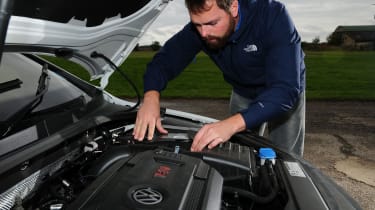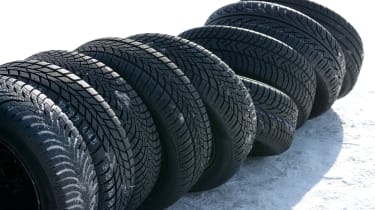It goes without saying that you need to keep your car in good condition throughout the year, but this takes a bit of extra thought in winter. Recovery firms say you’re twice as likely to break down during this season, but there are some precautions that you can take in order to avoid being stuck in the cold.
Now that the cold months have arrived, it’s advisable to take a bit of time to go over your motor and check that everything is as it should be. If you’re not sure where to start or exactly what to check, read on through our checklist to make sure you don’t miss anything.
We’ve included everything from the quick, easy tasks that take no time at all but can make all the difference, such as washer fluid and lighting checks, right up to more serious jobs, including fitting winter tyres. We’ve also included some recommended purchases where applicable.
Winter car maintenance checklist
Despite the added urgency of keeping your car well maintained during the winter, most of the checks are the same ones you would perform during the rest of the year. That said, there are a few points where a bit of extra winter attention wouldn’t go amiss.
Check your car battery
Cold and damp weather can put a strain on your car’s 12-volt battery. The lower temperatures already make it harder for an engine to turn over, but unfortunately, as any EV driver will tell you, cold weather also has a negative impact on a battery’s power output. If you haven’t changed your car battery recently, then it could be tired, and the cold weather could amplify the problem. If the battery struggles to provide enough power to start your car, the chances are it’s on its way out.
You can get a home battery tester and most are easy to use. If you do indeed need a replacement battery then, assuming you can start the car, you can drive to your local dealer or car spares shop to buy a new one. Most car battery stockists will also fit it for you.
Car battery prices vary, and models fitted with stop-start systems need a heavier-duty battery that can cost much more than the standard type, depending on the size, type and the electrical current produced. There are dozens of combinations on offer, so make sure you get the correct one for your car.

If you can’t start your car, but have access to a 12-volt power supply in another car, then you can use a set of jump leads. If you’re skilled enough and it’s accessible, you could remove the battery and charge it indoors. This can be complex, not least because car batteries are heavy. You should always refer to the owner’s manual.
Check antifreeze
Antifreeze, as its name suggests, stops the water in the engine’s cooling system from freezing. To test the effectiveness of your antifreeze, an antifreeze tester can be brought from your local car spares shop. To use it, unscrew the coolant reservoir cap under the bonnet (ensuring the engine is cold first), lower the tube into the coolant and squeeze the rubber bulb on the end to suck some antifreeze inside the tester.
You can then read the freezing point of the antifreeze using the scale inside the tester. Replace the antifreeze in the car’s system and replace the cap.
Check screen wash
Winter weather is frequently wet, and this draws all the dirt and road salt from the road surface, so you’ll spend lots of time using your windscreen wipers. Assuming your wipers are in good shape, there’s still a high risk of them smearing grime across the windscreen if your screen wash bottle is empty.

To ensure this doesn’t happen to you, open the windscreen washer bottle under the bonnet, and make sure that it is topped up. You can buy screenwash either ready-mixed or as a concentrate, which you’ll need to mix with water.
Screen wash has a lower freezing temperature than water alone, so you shouldn’t end up with frozen washer jets, although they can still become blocked if there’s a particularly heavy frost or freezing rain gets into them.
Check exterior lights
It sounds simple, and it is. The days are shorter and the weather is worse during the winter months, so maintenance of your exterior lights is an important aspect of any winter car checklist.
Check and clean your lights regularly. Salt and dirt can quickly build-up, reducing the effectiveness of the lights and reducing your visibility to other road users. It’s best to keep your lights on in all sorts of weather, because it helps you to be seen. Carry extra bulbs in case of a failure, but do try and learn how to replace the bulbs when it’s convenient, because when one does blow it’ll almost certainly be in the dark and possibly in cold and wet weather, too, not an ideal time to learn about your car.
Professional winter car checks
If you’ve not got the time to prepare your car for winter, then you can ask an expert to do it for you. Many main dealers and high street car spares shops can do this for a nominal fee. Some even offer free winter car checks, especially if your car is due a service around the same time.
Winter tyres
If you frequently drive in winter, then consider buying a set of winter tyres. They offer exceptional grip when the temperature drops below seven degrees, and while they’re effective in snow and ice, they also perform better than summer tyres when it’s wet. They’re not cheap, but are well worth the investment for the additional safety they bring.
It’s up to you whether you buy a second set of wheels to fit them on, but if you choose to swap the winter tyres onto the same wheels, it’s a job for a tyre fitter, as it’s a pretty tough job to do yourself.
Even if you don’t want the extra cost of winter tyres, checking the tread depth of your existing tyres is important. The legal limit is 1.6mm, but having more than this can dramatically improve steering and braking. Indeed, if your tyres require replacement, then winter is a good time to do it. Also, check your tyre pressures regularly, because these can change with the drop in air temperature with the changing of the seasons.

Winter car equipment
Carrying an emergency kit with you at all times through the winter might seem a bit extreme – but if you ever find yourself stranded you’ll be glad of it. We recommend:
- • A mobile phone and charger
- • A hazard warning triangle
- • Hi-visibility vest
- • A first aid kit
- • De-icer and a scraper
- • A shovel
- • A tow rope
- • Wellington boots
- • A torch
- • Warm clothes
- • Food and drink
And a decent set of car mats will not only protect your car’s carpets from wet or muddy feet, but can be wedged under the driven wheels to get you moving should you get really stuck in the snow.
What are your top tips for driving in winter weather? Let us know in the comments section below…
